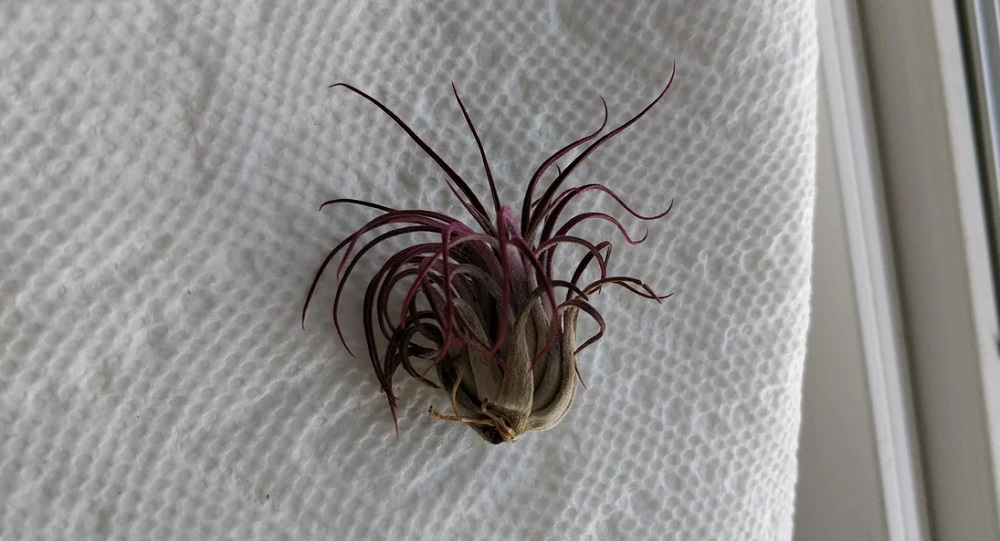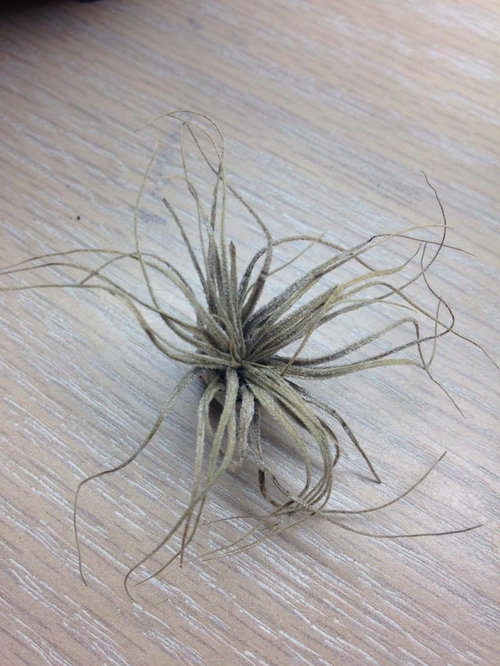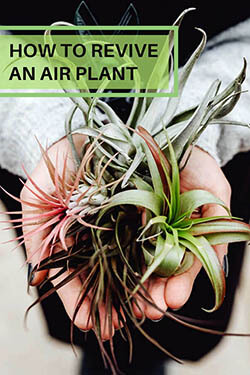
A dying air plant frequently has rot as a result of water accumulating in the plant’s crown. Between waterings, air plants must dry out. The air plant’s leaves will become brown or yellow, feel soft, and have a dying appearance if too much water builds up in the crown and doesn’t adequately drain away.
If they are not given enough water, air plants develop dark leaf tips and begin to curl.
If air plants are exposed to too much direct sunshine, they may turn brown or yellow.
If an air plant is kept under conditions that are incompatible with those of its natural environment, it begins to die.
Bright indirect light, watering at least twice a week, letting the air plant dry out before watering again, and maintaining a temperature range between 65°F and 85°F are all essential for reviving a dying air plant.
Continue reading to learn the causes of your air plant’s demise and how to put the remedies into practice to revive your drying air plant (Tillandsia)…
Table of Contents
Air Plant Turning Brown on the Ends
- Symptoms. The leaves of air plants become dry, brown, and curl at the ends.
- Low humidity, drowning, and probably too much sun and heat are the causes.
Underwatering is typically the cause of browning of the ends of air plants. Due to drought stress, the leaves begin to curl and turn brown at the ends. To avoid the ends of the leaf from turning brown, air plants need to be thoroughly watered up to twice a week with lukewarm water.
Low humidity, too much sun, and severe heat can also be factors in air plant leaf ends going brown and possibly curling up, although underwatering is by far the most major cause.
The ideal temperature for air plants is between 50 and 65°F during the day and 65 to 85°F at night.
If the temperature rises significantly, the rate of water loss from the leaves and the demand for water by the air plant both increase, which may cause the browning of the leaf tips.
Although air plants can tolerate some direct sunlight, they prefer to avoid it in the summer afternoons since the heat can cause them to lose too much moisture, which can cause the leaves to curl and become brown at the ends.
There are about 650 different species of air plants (Tillandsia), so it’s crucial to know where your particular variation comes from in order to determine why your air plant’s ends are going brown.
Air plants may flourish in both rainforests and scorching, arid desert-like environments. The frequency of watering depends on where your air plant is from.
The leaves are the simplest way to determine whether your air plant is native to a hot, dry climate or a rainforest:
- Silvery green leaves that have a more rounded appearance and frequently have a fuzzy texture are native to dry regions and need less irrigation, whereas…
- Rainforest plants need misting every few days and more frequent watering since their dark green, less scaly leaves are more curled.
It’s crucial to note that both varieties of air plants’ leaves can become brown at the ends from submersion, but those that are indigenous to tropical rainforests tend to exhibit brown leaf ends far more frequently.
The leaves on your air plants are going brown at the ends because you are watering them less frequently than once every seven days.
How to Revive an Air Plant with Brown Leaf Ends
If the ends of your air plants’ leaves have turned brown, you can revive them by giving them a nice bath in lukewarm water to help the leaves absorb all the water they need. Then, transfer the plant to a cooler location that is shielded from direct sunlight so it can recuperate.
- For ten minutes, submerge your air plant in a bowl of water to assist the brown leaves regenerate. Instead of using their roots, air plants absorb water through their leaves. When the air plant is submerged, the leaves have the chance to absorb the water they need to combat drought stress and regenerate the brown ends.
- To prevent shock, make sure the water is lukewarm. Ideally, leave the water in the container overnight to allow chlorine and fluoride to evaporate, which can cause the leaf tips of some, more delicate varieties of air plants to turn brown.
- To avoid brown leaf ends, water your air plant at least twice every week. If the leaves are curling and turning brown at the tips, water them more frequently. The ideal watering frequency varies on whether the type of air plant originates from an arid area (silvery, green leaves) or a rainforest one (dark, green foliage). Although this is general advice and your watering should be adjusted for your environment and conditions, it is typically advised to water air plants with dark green leaves up to four times per week and air plants with silvery green foliage about twice per week.
- After watering, hang your air plant upside down for a while. Although air plants need to be watered fairly frequently, they are also prone to decay if water collects in the plant’s crown. To maintain the ideal balance of moisture, place the air plant somewhere where there is some air movement so that it can dry out in between waterings.
- Make sure the room the air plant is in has a temperature range of between 65 and 85°F during the day and between 50 and 65°F at night. The ideal temperature range for all types of air plants is within this range. If indoor heating sources are drying out your air plant, consider moving it to a cooler area to aid in the recovery of the brown ends.
- In the summer, move air plants out of the sun’s direct rays in the afternoons. In general, air plant species with dark green leaves prefer bright indirect light or possibly some filtered light, whereas those with silvery green leaves can endure more sun. Finding a site with bright, indirect light or early sun followed by afternoon shade is excellent because intense sunshine in the summer is too much for most air plants.
- By putting them in the bathroom or spraying them once a week, dark green air plant species can benefit from increased humidity. By misting the air plant, you may simulate the greater humidity levels seen in its original tropical jungle. Just watch out that water doesn’t pool at the leaf’s base, as that can lead to decay.
Should I Cut the Brown Leaf Tips off Air Plants?
If the leaf tip of an air plant has turned brown and crispy, you can remove it with a pair of pruners or scissors. This promotes the growth of strong, green leaf tips and improves the appearance of the air plant.
Once well-watered, shielded from direct sunshine, and maintained between 65 and 85°F to help simulate the circumstances of its natural habitat, an air plant with brown leaf tips should recover.
Air Plant Turning Brown, Yellow or Black (Due to Rot)
- Symptoms. The air plant can develop mushy, brown or black patches that are typically found towards the plant’s crown.
- Causes. Lack of letting the air plant to dry between waterings, failure to drain the plant after watering, poor air circulation, and chilly conditions all contribute to water pooling at the plant’s crown in the leaves.
Rot, brought on by water collecting in the leaves at the plant’s top and freezing temperatures, is the reason why air plants turn brown. To prevent excessive moisture from causing the plant to decay and turn brown, air plants must be hanged upside down and given time to dry out in between watering sessions.
As they cling to trees and rocks in their natural habitat, air plants are accustomed to well-draining circumstances and do not tolerate water standing in their structure, which is typically near the plant’s crown.
Since they often grow at an angle (when connected to a tree branch), which allows water to drain away from the plant between rainfalls, rot is typically prevented in their natural environment.
The softly textured leaves may turn brown, yellow, or black. Rot typically results from water that becomes trapped in the plant after watering, although other factors can include:
- excessive sprinkling results in water collecting at the plant’s crown.
- avoiding letting the air plant dry up in between waterings.
- not hanging your watered air plant upside down (to allow the water to drain properly)
- a lack of airflow that aids in allowing the leaves to dry out after watering.
- Rot is facilitated by nighttime lows of 50°F and daytime highs of less than 65°F.
Since they frequently get too cold in the winter, air plants typically don’t like to spend the night on windowsills.
Additionally, the leaves can come into contact with the window’s glass, which may be considerably colder than the room’s ambient temperature.
How to Revive Air Plants Turning Brown

In order to avoid potentially transferring fungal diseases from unhealthy sections of the plant to otherwise healthy growth, wipe the pruner blades with a cloth dipped in disinfectant before each cut. Then, follow these best practices for maintenance:
- Never water your air plant again until it has dried out. In order to ensure that extra water has been drained away from the air plant’s crown, where water most frequently gets stuck and leads to rot, the air plant must be suspended upside down for at least 20 minutes.
- To ensure that the air plant dries out between waterings, make sure there is excellent air circulation. Due to their adaptation to growing in open spaces or high in trees, air plants prefer some air movement, which aids in keeping them dry and prevents rot. Air plants prefer to be near windows that are open as opposed to stuffy rooms, and they can withstand air currents from air conditioning in the summer, which can help prevent rot.
- After watering, hang your air plant upside down to avoid brown rot. In order to induce water to run off the plant rather than collect in the leaves at the air plant’s top, air plants need to be soaked in water, dried for at least 30 minutes, and then oriented upside down.
- Make sure the room where your air plant is located does not experience nighttime temperatures below 50°F. The ideal temperature range is 50°F to 65°F at night and 65°F to 85°F during the day. The evaporation of the leaves is slowed down by cold temperatures, and frost can damage the air plants and turn them soft and black.
For the best balance of watering, it is typically advised to run the tap on air plants from dry, desert locations twice a week and on plants from rainforest regions four times a week.
This soak-and-dry method of watering ensures that the air plant receives adequate moisture to avoid rot from overwatering as well as drought-induced browning of the leaf tips.
The amount of sun exposure and the climate will determine how frequently you should water your air plant, but I must stress that you should wait until the plant feels completely dry before giving it another drink. This is because an air plant that has been underwatered (with brown leaf tips) is much easier to revive than one that is rotting away.
Air Plant Turning Brown or Yellow (Excess Sun Exposure)
- Symptoms. Burning brown or yellow air plants.
- Causes. excessive sun exposure, with low humidity and high temperature as influencing factors.
When air plants receive too much direct sunshine in the summer, they frequently start to turn brown or yellow and eventually turn burned brown. Air plants do need bright light and frequently prefer sunshine, however they can get brown in the summer due to the intense heat and high temperatures.
The most popular types of air plants are native to dry, arid areas or rainforests, where the leaves are often dark green (which have silvery, green leaves).
Dark green leaves on air plants are more likely to scorch in the summer and turn brown or yellow, especially if they are exposed to direct sunlight for an extended period of time.
However, if they are abruptly relocated from a more shady position to one with direct sunlight that they haven’t had time to acclimate to, all species of air plants risk scorching to a brown or yellow color.
If the temperature is over 85 degrees Fahrenheit and the weather is very dry, the air plant is more prone to become brown in the sun.
How to Revive a Air Plant Turning Brown or Yellow due to Excess Sun Exposure

The rot spreads throughout the air plant, making it very challenging to salvage an air plant that is going brown and dying from the rot. Occasionally, using a good pair of pruners, it is possible to remove any rotting areas of the plant (if the brown rotting area is relatively localized).
To avoid the risk of transmitting fungi from damaged plant parts to healthy growth, wipe the pruner blades with a towel dipped in disinfectant between each cut. Then, follow these best practices for maintenance:
Before watering it once more, always let your air plant dry out. This entails holding the air plant upside down for at least 20 minutes to make sure any extra water has been drained away from the plant’s crown, where water most frequently gets trapped and results in rot.
Key Takeaways:
- To ensure that the air plant dries out in between waterings, maintain excellent air circulation. Air circulation is preferred by air plants because it enables them to dry and prevents rot because they are evolved to growing in open regions or high in trees. The air currents from air conditioning in the summer can help prevent decay, and air plants prefer to be near an open window rather than in a stuffy room.
- For protection against brown rot, hang your air plant upside down after watering. When air plants are immersed in water and then left to dry for at least 30 minutes, they do well. The plants should also be oriented upside down to enable water to drain off the plant rather than collect in the leaves at the crown.
- Ensure that your air plant is in a space with a nighttime temperature of no lower than 50°F. 65°F to 85°F for the day and 50°F to 65°F at night are the ideal temperature ranges. The evaporation of water from the leaves is slowed down in colder climates, and frost can rot and turn air plants soft and black.
- For the best balance of watering, it is typically advised to water air plants from dry, desert locations twice a week by running them under the faucet and air plants from rainforest regions four times a week.
- This soak-and-dry method of watering ensures that the air plant receives enough moisture to prevent rot from overwatering as well as the browning of the leaf tips caused by dehydration.
- It will depend on the climate and the amount of sunlight your air plant receives as to how frequently you should water it, but I must stress that you should wait until the plant feels completely dry before you water it again. This is because an air plant that has been underwatered (with brown leaf tips) is much easier to revive than one that is rotting from the inside out.
FAQ
Why is the base of my air plant turning brown?
Causes. excessive sun exposure, as well as high temperature and low humidity, are the main causes.
How do you save a Browning air plant?
Too much direct sunshine in the summer causes air plants to develop a burned brown, which is frequently the cause of their turning brown or yellow. Although they frequently prefer sunlight, air plants do need bright light, but in the summer, when temperatures are high and the sun is really powerful, air plants start to become brown.
